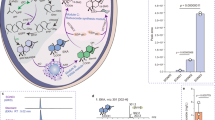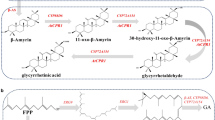Abstract
Rebaudioside A has superior taste quality among the steviol glycosides extracted from Stevia rebaudiana leaves. Given its high purity as a general-purpose sweetener, rebaudioside A has received significant attention and has been widely applied in food and beverages in recent decades. Stevioside is one of the major steviol glycosides and can be converted to rebaudioside A by the uridine-diphosphate dependent glucosyltransferase UGT76G1 in S. rebaudiana. To explore the applicability of and limits in producing rebaudioside A from stevioside through whole-cell biocatalysis, the engineered Saccharomyces cerevisiae expressing UGT76G1, using a newly constructed constitutive expression vector, was used as the whole-cell biocatalyst. Citrate was added to the reaction mixture to allow metabolic regulation when glucose was fed to provide the activated sugar donor UDP-glucose for glycosylation of stevioside in vivo. In an evaluation of the whole-cell reaction parameters involving cell permeability, temperature, pH, citrate and Mg2+ concentrations, and glucose feeding, production of 1160.5 mg/L rebaudioside A from 2 g/L stevioside was achieved after 48 h without supplementation of extracellular UDP-glucose.








Similar content being viewed by others
References
Carakostas, M. C., Curry, L. L., Boilea, A. C., & Brusick, D. (2008). Overview: the history, technical function and safety of rebaudioside A, a naturally occurring steviol glycoside, for use in food and beverages. Food and Chemical Toxicology, 46(7), S1–S10.
Wu, X. L., Wang, B. G., Chen, T. T., Gan, M., Chen, X. X., Chen, F., Wei, H., & Xu, F. (2014). The non-cytotoxicity characterization of rebaudioside A as a food additive. Food and Chemical Toxicology, 66, 334–340.
Huang, X. Y., Fu, J. F., & Di, D. L. (2010). Preparative isolation and purification of steviol glycosides from Stevia rebaudiana Bertoni using high-speed counter-current chromatography. Separation and Purification Technology, 71(2), 220–224.
Li, J., Chen, Z. B., & Di, D. L. (2012). Preparative separation and purification of Rebaudioside A from Stevia rebaudiana Bertoni crude extracts by mixed bed of macroporous adsorption resins. Food Chemistry, 132(1), 268–276.
Lui, Y. F., Di, D. L., Bai, Q. Q., Li, J. T., Chen, Z. B., Lou, S., & Ye, H. L. (2011). Preparative separation and purification of rebaudioside A from steviol glycosides using mixed-mode macroporous adsorption resins. Journal of Agricultural and Food Chemistry, 59(17), 9629–9636.
Ye, F. Y., Yang, R. J., Hua, X., & Zhao, G. H. (2014). Adsorption characteristics of rebaudioside A and stevioside on cross-linked poly(styrene-co-divinylbenzene) macroporous resins functionalized with chloromethyl, amino and phenylboronic acid groups. Food Chemistry, 159, 38–46.
Brandle, J. E., Starratt, A. N., & Gijzen, M. (1998). Stevia rebaudiana: its agricultural, biological, and chemical properties. Canadian Journal of Plant Science, 78(4), 527–536.
Scipioni, G. P., Ferreyra, D. J., Acuna, M. G., & Schmalko, M. E. (2010). Rebaudioside A release from matrices used in a yerba mate infusion. Journal of Food Engineering, 100(4), 627–633.
Prakash, I., DuBois, G. E., Cios, J. F., Wilkens, K. L., & Fosdick, L. E. (2008). Development of rebiana, a natural, non-caloric sweetener. Food and Chemical Toxicology, 46(7), S75–S82.
Brandle, J. E., & Telmer, P. G. (2007). Steviol glycoside biosynthesis. Phytochemistry, 68(14), 1855–1863.
Humphrey, T. V., Richman, A. S., Menassa, R., & Brandle, J. E. (2006). Spatial organisation of four enzymes from Stevia rebaudiana that are involved in steviol glycoside synthesis. Plant Molecular Biology, 61(1–2), 47–62.
Richman, A., Swanson, A., Humphrey, T., Chapman, R., McGarvey, B., Pocs, R., & Brandle, J. (2005). Functional genomics uncovers three glucosyltransferases involved in the synthesis of the major sweet glucosides of Stevia rebaudiana. Plant Journal, 41(1), 56–67.
Madhav, H., Bhasker, S., & Chinnamma, M. (2013). Functional and structural variation of uridine diphosphate glycosyltransferase (UGT) gene of Stevia rebaudiana-UGTSr involved in the synthesis of rebaudioside A. Plant Physiology and Biochemistry, 63, 245–253.
de Carvalho, C. C. C. R. (2011). Enzymatic and whole cell catalysis: finding new strategies for old processes. Biotechnology Advances, 29(1), 75–83.
Ruffing, A., & Chen, R. R. (2006). Metabolic engineering of microbes for oligosaccharide and polysaccharide synthesis. Microbial Cell Factories, 5.
Werner, S. R., & Morgan, J. A. (2009). Expression of a Dianthus flavonoid glucosyltransferase in Saccharomyces cerevisiae for whole-cell biocatalysis. Journal of Biotechnology, 142(3–4), 233–241.
Oka, T., & Jigami, Y. (2006). Reconstruction of de novo pathway for synthesis of UDP-glucuronic acid and UDP-xylose from intrinsic UDP-glucose in Saccharomyces cerevisiae. FEBS Journal, 273(12), 2645–2657.
Bloxham, D. P., & Lardy, H. A. (1973). In P. D. Boyer (Ed.), The enzymes (pp. 239–278). New York.
Partow, S., Siewers, V., Bjorn, S., Nielsen, J., & Maury, J. (2010). Characterization of different promoters for designing a new expression vector in Saccharomyces cerevisiae. Yeast, 27(11), 955–964.
Bradford, M. M. (1976). A rapid and sensitive method for the quantitation of microgram quantities of protein utilizing the principle of protein-dye binding. Analytical Biochemistry, 72, 248–254.
Gatignol, A., Dassain, M., & Tiraby, G. (1990). Cloning of Saccharomyces cerevisiae promoters using a probe vector based on phleomycin resistance. Gene, 91(1), 35–41.
Ogden, J. E., Stanway, C., Kim, S., Mellor, J., Kingsman, A. J., & Kingsman, S. M. (1986). Efficient expression of the Saccharomyces cerevisiae PGK gene depends on an upstream activation sequence but does not require TATA sequences. Molecular and Cellular Biology, 6(12), 4335–4343.
Holland, M. J., & Holland, J. P. (1978). Isolation and identification of yeast messenger ribonucleic acids coding for enolase, glyceraldehyde-3-phosphate dehydrogenase, and phosphoglycerate kinase. Biochemistry, 17(23), 4900–4907.
Lin, J., Liao, X. Y., Du, G. C., & Chen, J. (2010). Use of Escherichia coli add/ade mutant and Saccharomyces cerevisiae WSH2 to construct a highly efficient coupled system for glutathione production. Enzyme and Microbial Technology, 46(2), 82–86.
Laouar, L., Lowe, K. C., & Mulligan, B. J. (1996). Yeast responses to nonionic surfactants. Enzyme and Microbial Technology, 18(6), 433–438.
Parrou, J. L., Teste, M. A., & Francois, J. (1997). Effects of various types of stress on the metabolism of reserve carbohydrates in Saccharomyces cerevisiae: genetic evidence for a stress-induced recycling of glycogen and trehalose. Microbiology, 143, 1891–1900.
Wilson, W. A., Roach, P. J., Montero, M., Baroja-Fernandez, E., Munoz, F. J., Eydallin, G., Viale, A. M., & Pozueta-Romero, J. (2010). Regulation of glycogen metabolism in yeast and bacteria. FEMS Microbiology Reviews, 34(6), 952–985.
Persson, M., & Palcic, M. M. (2008). A high-throughput pH indicator assay for screening glycosyltransferase saturation mutagenesis libraries. Analytical Biochemistry, 378(1), 1–7.
Prakash, I., Clos, J. F., & Chaturvedula, V. S. P. (2012). Stability of rebaudioside A under acidic conditions and its degradation products. Food Research International, 48(1), 65–75.
Boels, I. C., Kleerebezem, M., & de Vos, W. M. (2003). Engineering of carbon distribution between glycolysis and sugar nucleotide biosynthesis in Lactococcus lactis. Applied and Environmental Microbiology, 69(2), 1129–1135.
Rodriguez-Diaz, J., & Yebra, M. J. (2011). Enhanced UDP-glucose and UDP-galactose by homologous overexpression of UDP-glucose pyrophosphorylase in Lactobacillus casei. Journal of Biotechnology, 154(4), 212–215.
Oh, J. S. (2008). Disaccharide synthesis using E. coli UDP-glucose regeneration system. Korean Journal of Biotechnology and Bioengineering, 23(6), 474–478.
Mao, Z., Shin, H. D., & Chen, R. R. (2006). Engineering the E. coli UDP-glucose synthesis pathway for oligosaccharide synthesis. Biotechnology Progress, 22(2), 369–374.
Yan, Y., Li, Z., & Koffas, M. A. (2008). High-yield anthocyanin biosynthesis in engineered Escherichia coli. Biotechnology and Bioengineering, 100(1), 126–140.
Author information
Authors and Affiliations
Corresponding author
Ethics declarations
Funding
This work was financially supported by PAPD, NSFC (grant number 21106068), and Doctoral Fund of Ministry of Education of China (grant number 20113221120002).
Conflict of Interest
The authors declare that they have no competing interests.
Rights and permissions
About this article
Cite this article
Li, Y., Li, Y., Wang, Y. et al. Production of Rebaudioside A from Stevioside Catalyzed by the Engineered Saccharomyces cerevisiae . Appl Biochem Biotechnol 178, 1586–1598 (2016). https://doi.org/10.1007/s12010-015-1969-4
Received:
Accepted:
Published:
Issue Date:
DOI: https://doi.org/10.1007/s12010-015-1969-4




